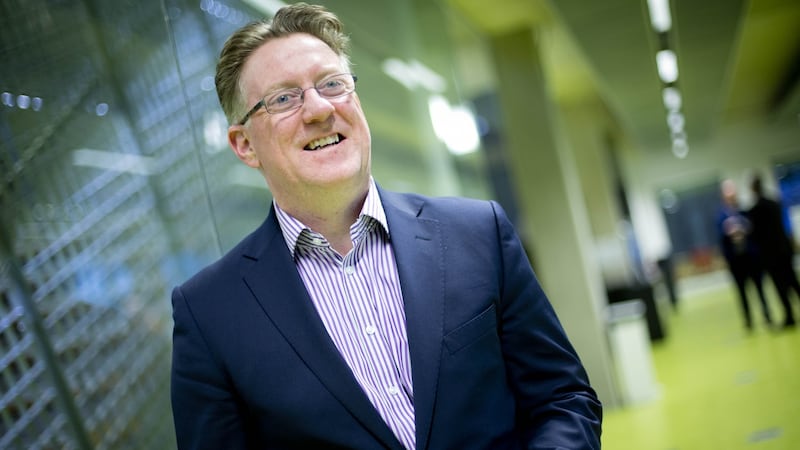Stepaside Educate Together secondary school is one of Ireland's newest schools, having opened its doors last August. It is also among the most technologically advanced, with all students and teachers using Microsoft Surface devices.
The school’s ethos is to strive for appropriate excellence in all areas and develop in students the skills, knowledge and resilience that will enable them to contribute meaningfully to their school and the wider community.
There is a strong focus on active collaboration and cross-curricular projects. The emphasis is on higher-order learning and thinking, as opposed to the traditional rote-learning model, concentrating on the process as much as on the content. This involves a shift from subject-based learning and a focus instead on cognitive skills, problem-solving and the development of the whole person.

"We want to stimulate curiosity in our students and teachers," says school principal Barbara Mulhall. "As an Educate Together school we are very conscious of our learning model, which is designed with the learning process in mind. We believe that how we learn is as important as what we learn. We use the Bridge 21 model. Bridge 21 is based in Trinity College Dublin and the model is team-based, technology-mediated, project-based and cross- curricular."
While it is technology-mediated, she points out that the technology is just a tool which allows learning to go to another level. “That’s how Microsoft came in,” Mulhall adds. “All students and teachers use Microsoft Surface devices for every class but not all the time. It’s not just about spending 40 minutes a week in a computer room.”
No textbooks
Students don’t use any textbooks. “The teachers create resources and content with the students,” she says. “There involves really great collaboration between them. We have created a virtual-learning environment where teachers upload resources that students can access from home or anywhere. They can access everything that they did in class and upload their homework. They can also collaborate on projects, correct and reflect on them all in the virtual-learning environment.”
Homework assignments can be in writing and can be on Minecraft, Sway or even offline. Parents can access the virtual-learning environment as well allowing them to help their children when necessary.
One hugely important aspect of the virtual-learning environment is the calendar. This shows the students what homework they have and when it is due for submission. It also shows them their timetable and other important events. Teachers can use it to track what homework is in and what is still due.
The virtual-learning environment also allows teachers keep an eye on homework being done. “If a student is having difficulty with their homework they can go online and ask their peers for help. The teacher can step in to guide and assist whenever needed. This makes the teacher available outside the class and the school and this is very important to students.”
“Microsoft has been working with schools across the globe for the past decade,” says Kevin Marshall, head of education with Microsoft Ireland. “These include several in Ireland which have become exemplars of the use of technology in teaching and learning.
“As time has gone on, the needs of the schools have changed and so have the technology and our approach. The opportunity to work with Stepaside Educate Together secondary school has been very interesting from our perspective. It is a new school on a greenfield site and is less constrained by the way things have been done before. This made it quite exciting from our point of view.”
Stepaside Educate Together has also been selected to take part in a new Microsoft Stem initiative. “Microsoft has a Stem [science, technology, engineering and maths] initiative beginning early next year involving 27 schools across western Europe and Stepaside will be one of them,” says Marshall. “We are bringing the schools together in May in Brussels to discuss Stem and how it can be embedded in schools and the curriculum.
Computational thinking
“There is a big push at policy level to put computer science on the Leaving Cert,” he says. “The challenge is to give teachers the confidence to teach it. The interesting thing is to look at teachers across the board. There is no reason why a good art or French teacher can’t also be a good computer science teacher. Teaching won’t be domain-specific in future. We also need to explore the whole concept of computational thinking over the next decade. This will be critical for our skills in areas like data science and artificial intelligence in future.”
Mulhall agrees emphatically. “We are very conscious of the 21st-century digital economy where creativity is the new productivity,” she says. “We are preparing students for careers that don’t exist yet. We have to help them develop computational thinking as well as the research and critical-thinking skills which will help them evaluate all the information coming at them in this post-truth era.”
But it’s not just about learning, of course. “Student wellbeing is hugely important to us as well. We very much put Maslow before Bloom. We also place great emphasis on collaboration. It is great to see students learning from each other and learning that they can achieve more as a group than they can on their own.”











